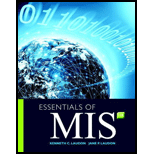
Concept explainers
Explanation of Solution
Business intelligence and Business analytics:
Business intelligence refers to technologies, applications, infrastructures and tools that performance a main role in the planning process of the corporation.
- The set-up for analyzing data, reporting, warehousing and combining data from the business atmosphere.
- It gathers, stores, clean and makes appropriate data offered to managers. It consist of databases, data warehouses, and data markets...
Explanation of Solution
Elements of a Business intelligence environment:
- 1) Data from the business environment:
Different sources of organized and unorganized data, Internet and mobile devices are combined and used by the people decision makers.
- 2) Business intelligence infrastructure:
Strong
- 3) Business analytics tools:
Software tools used to examine data and send respond, reports to manager queries and use key pointers of presentation to follow a business growth...
Explanation of Solution
Analytic functionalities provided by Business intelligence systems:
- 1) Production reports
The predefined reports are constructed on business agree requirements.
- 2) Parameterized reports
An Operators enter numerous constraints in a pivot table to screen data and separate effects of the constraints.
- 3) Dashboards and scorecards
Visual tools is used to presenting records as created by users...
Explanation of Solution
Predictive analytics and location analytics with examples:
Predictive analytics is defined as an extracting data from existing data sets which is used for analysis of statistics, mining and for upcoming expectations to forecast future developments and performance designs. It comprises the skill to develop the future actions and performance for past events.
Two examples of Predictive analytics:
- 1) Predict age, gender, location and driving records in insurance policy companies to begin appropriate cost of plans.
- 2) Predict the customer response to the product depends on offers in the product by the retailers...
Explanation of Solution
Types of Business intelligence users:
- 1) Power users
Nearly 20 percent of employees in the groups of business analysts, IT developers, analytical modelers and super users who producing new analyses, models, reports and forecasts.
- 2) Casual users
Other 80 percent...
Explanation of Solution
Balanced scorecard method and business performance management:
Balanced scorecard method:
A senior manager can create the outline for operating a secure plan by concentrating on computable results on four views of the performance of organizations. They are business process, customer, financial, growth and learning. This method helps to increase the customer satisfaction, business process efficiency and improvement in the employee activities...
Want to see the full answer?
Check out a sample textbook solution
Chapter 11 Solutions
Essentials of MIS (12th Edition)
- what is a feature in the Windows Server Security Compliance Toolkit, thank you.arrow_forwardYou will write a program that allows the user to keep track of college locations and details about each location. To begin you will create a College python class that keeps track of the csollege's unique id number, name, address, phone number, maximum students, and average tuition cost. Once you have built the College class, you will write a program that stores College objects in a dictionary while using the College's unique id number as the key. The program should display a menu in this order that lets the user: 1) Add a new College 2) Look up a College 4) Delete an existing College 5) Change an existing College's name, address, phone number, maximum guests, and average tuition cost. 6) Exit the programarrow_forwardShow all the workarrow_forward
- Show all the workarrow_forward[5 marks] Give a recursive definition for the language anb2n where n = 1, 2, 3, ... over the alphabet Ó={a, b}. 2) [12 marks] Consider the following languages over the alphabet ={a ,b}, (i) The language of all words that begin and end an a (ii) The language where every a in a word is immediately followed by at least one b. (a) Express each as a Regular Expression (b) Draw an FA for each language (c) For Language (i), draw a TG using at most 3 states (d) For Language (ii), construct a CFG.arrow_forwardQuestion 1 Generate a random sample of standard lognormal data (rlnorm()) for sample size n = 100. Construct histogram estimates of density for this sample using Sturges’ Rule, Scott’s Normal Reference Rule, and the FD Rule. Question 2 Construct a frequency polygon density estimate for the sample in Question 1, using bin width determined by Sturges’ Rule.arrow_forward
 Principles of Information Systems (MindTap Course...Computer ScienceISBN:9781305971776Author:Ralph Stair, George ReynoldsPublisher:Cengage Learning
Principles of Information Systems (MindTap Course...Computer ScienceISBN:9781305971776Author:Ralph Stair, George ReynoldsPublisher:Cengage Learning Fundamentals of Information SystemsComputer ScienceISBN:9781337097536Author:Ralph Stair, George ReynoldsPublisher:Cengage Learning
Fundamentals of Information SystemsComputer ScienceISBN:9781337097536Author:Ralph Stair, George ReynoldsPublisher:Cengage Learning Management Of Information SecurityComputer ScienceISBN:9781337405713Author:WHITMAN, Michael.Publisher:Cengage Learning,
Management Of Information SecurityComputer ScienceISBN:9781337405713Author:WHITMAN, Michael.Publisher:Cengage Learning, Fundamentals of Information SystemsComputer ScienceISBN:9781305082168Author:Ralph Stair, George ReynoldsPublisher:Cengage Learning
Fundamentals of Information SystemsComputer ScienceISBN:9781305082168Author:Ralph Stair, George ReynoldsPublisher:Cengage Learning Database Systems: Design, Implementation, & Manag...Computer ScienceISBN:9781305627482Author:Carlos Coronel, Steven MorrisPublisher:Cengage Learning
Database Systems: Design, Implementation, & Manag...Computer ScienceISBN:9781305627482Author:Carlos Coronel, Steven MorrisPublisher:Cengage Learning





